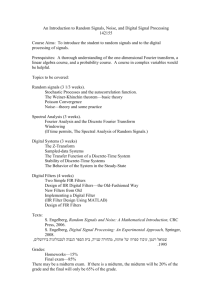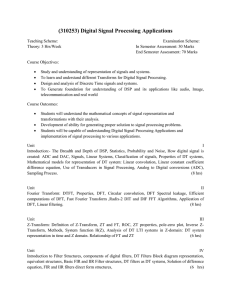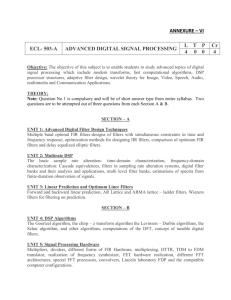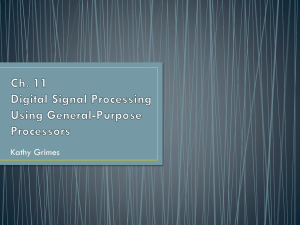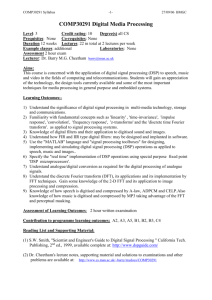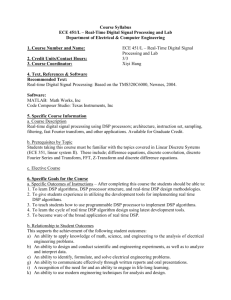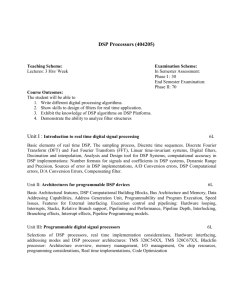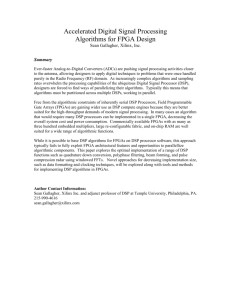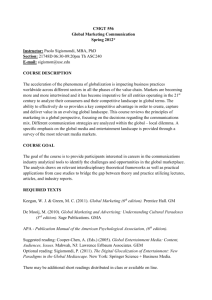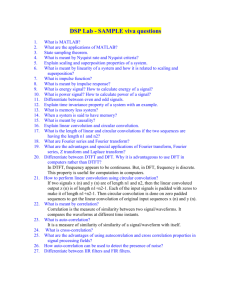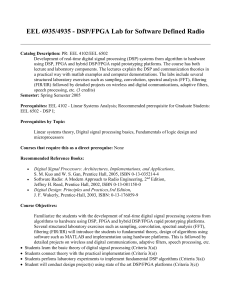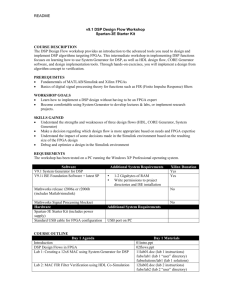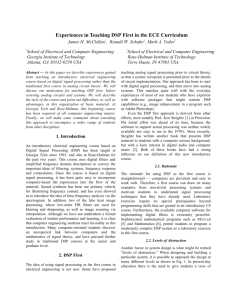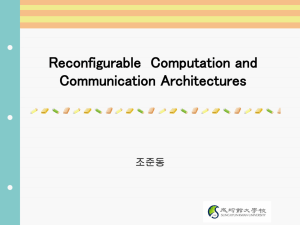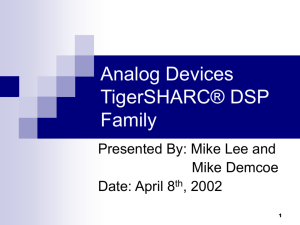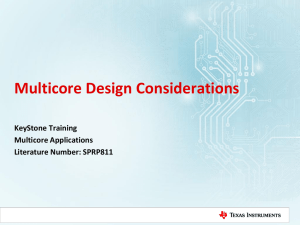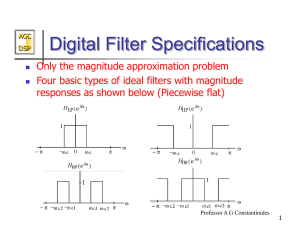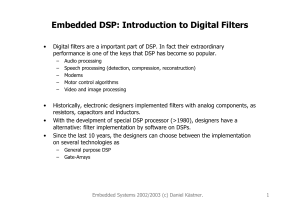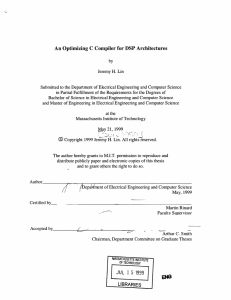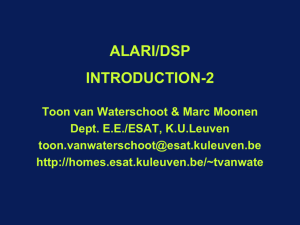EEE 407 Digital Signal Processing
advertisement
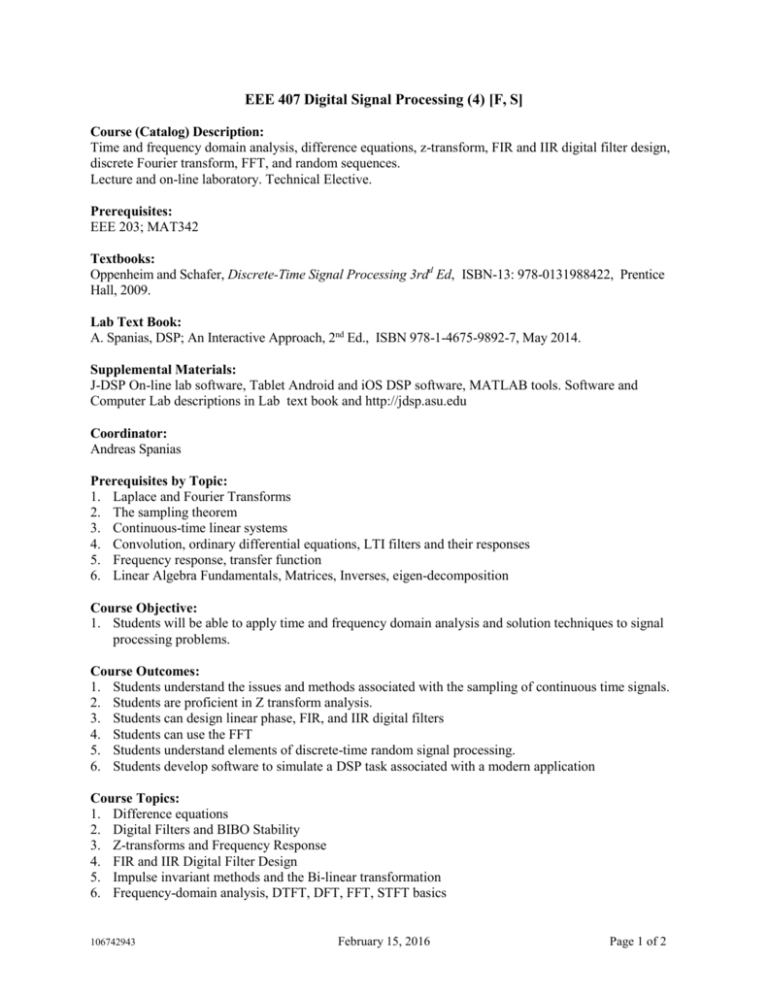
EEE 407 Digital Signal Processing (4) [F, S] Course (Catalog) Description: Time and frequency domain analysis, difference equations, z-transform, FIR and IIR digital filter design, discrete Fourier transform, FFT, and random sequences. Lecture and on-line laboratory. Technical Elective. Prerequisites: EEE 203; MAT342 Textbooks: Oppenheim and Schafer, Discrete-Time Signal Processing 3rdd Ed, ISBN-13: 978-0131988422, Prentice Hall, 2009. Lab Text Book: A. Spanias, DSP; An Interactive Approach, 2nd Ed., ISBN 978-1-4675-9892-7, May 2014. Supplemental Materials: J-DSP On-line lab software, Tablet Android and iOS DSP software, MATLAB tools. Software and Computer Lab descriptions in Lab text book and http://jdsp.asu.edu Coordinator: Andreas Spanias Prerequisites by Topic: 1. Laplace and Fourier Transforms 2. The sampling theorem 3. Continuous-time linear systems 4. Convolution, ordinary differential equations, LTI filters and their responses 5. Frequency response, transfer function 6. Linear Algebra Fundamentals, Matrices, Inverses, eigen-decomposition Course Objective: 1. Students will be able to apply time and frequency domain analysis and solution techniques to signal processing problems. Course Outcomes: 1. Students understand the issues and methods associated with the sampling of continuous time signals. 2. Students are proficient in Z transform analysis. 3. Students can design linear phase, FIR, and IIR digital filters 4. Students can use the FFT 5. Students understand elements of discrete-time random signal processing. 6. Students develop software to simulate a DSP task associated with a modern application Course Topics: 1. Difference equations 2. Digital Filters and BIBO Stability 3. Z-transforms and Frequency Response 4. FIR and IIR Digital Filter Design 5. Impulse invariant methods and the Bi-linear transformation 6. Frequency-domain analysis, DTFT, DFT, FFT, STFT basics 106742943 February 15, 2016 Page 1 of 2 7. 8. 9. 10. 11. Multi-rate signal processing, Σ-Δ A/D, simple sub-band QMF design Deterministic vs random sequences Stationary and ergodic sequences The mean and the autocorrelation Signal processing application algorithm design and implementation Computer Usage: - Students use the computer to perform several on-line NSF-sponsored J-DSP laboratories on key DSP topics including design of FIR, IIR, and QMF filters. Laboratories are outlined below - Students execute a computer project involving C or MATLAB programming Laboratory Experiments: EEE 407 has both on-campus and distance learning students. Students execute a series of computer laboratories using the NSF-funded on-line software Java-DSP. The software enables students to perform comprehensive on-line simulations of DSP algorithms. A TA coordinates the laboratory, grades electronic lab reports, holds office hours for students. Laboratories include: - Lab 1: Continuous and discrete-time convoolution - Lab 2: The z-transform and frequency responses - Lab 3: Pole-Zero Plots and Frequency Responses - Lab 4: Linear Phase, FIR Filter Design by Windowing / IIR Filters design - Lab 5: The Fast Fourier Transform (FFT) - Lab 6: Multirate Signal Processing and QMF banks Course Contribution to Engineering Science and Design: Students are required to solve open-ended problems both as part of the homework and as part of the laboratory exercises. Course involves filter design using several methods and participants are asked to analyze these filter design methods and perform comparisons. Students are asked to design algorithmic steps and develop software to execute a specific signal processing task in terms of a MATLAB- or Cbased programming project. Course Relationship to Program Outcomes: a: Students are exposed to the fundamental theory and applications of digital signal processing (DSP). Students receive exposure by analyzing in-depth of certain basic problems and applications, conduct computer laboratories and interpret data, develop DSP simulations (multi-rate sampling, filtering, FFTbased spectral analysis, random signal processing). Students obtain models for simple DSP algorithms and their properties. c: DSP is an enabling technology for information exchange, telecommunications, wireless networks, digital audio (MP 3), multimedia and cinema surround sound applications. As such, it involves considerable component design and integration. e: Open-ended problems are discussed from signal processing, telecommunications, rich-media productions, PC/internet, audio entertainment technologies, defense applications, sensor signal processing. k: Students get exposed to Java-DSP, Tablet and MATLAB software for signal analysis and DSP algorithm simulation. Person(s) preparing this description and date of preparation: A.S. Spanias, K. Tsakalis, February 2015 106742943 February 15, 2016 Page 2 of 2
